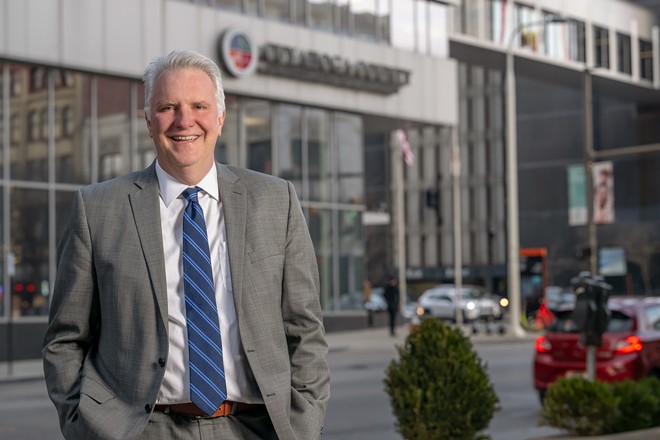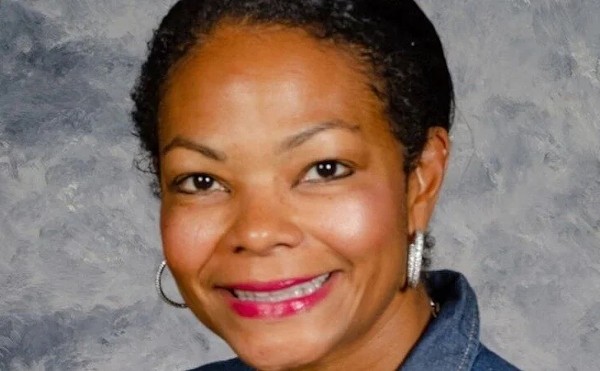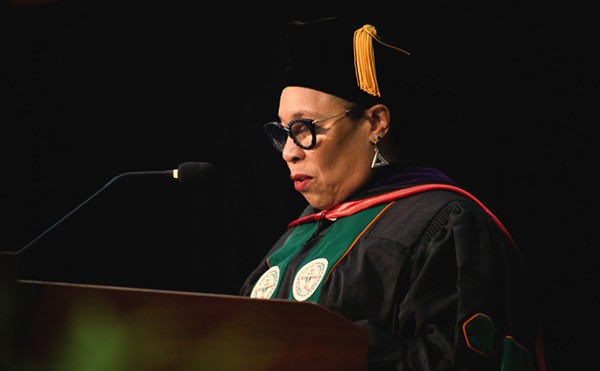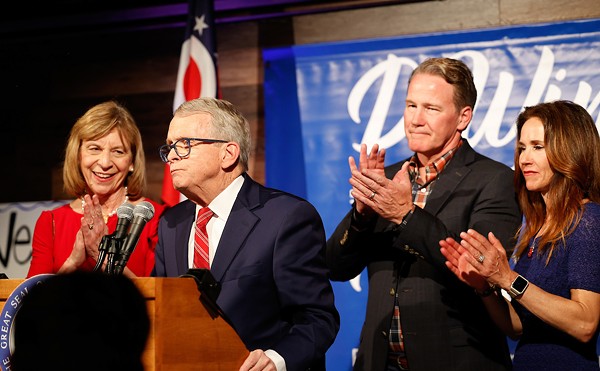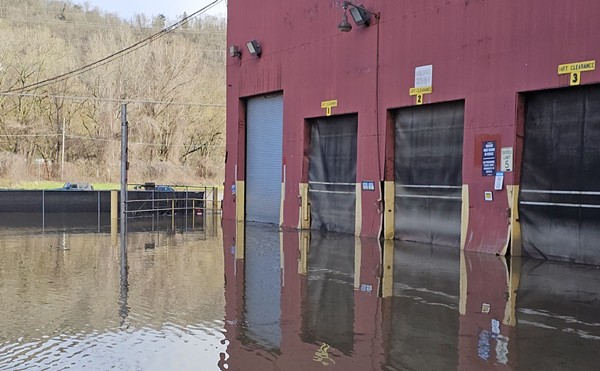Chris Ronayne on Funding for the Homeless, Re-entry Services, a Stadium (Not That One) and the City’s Plan to TIF Downtown
After a year of big lifts for Cuyahoga County, the executive takes stock at the quarter pole
By Vince Grzegorek on Wed, Jan 31, 2024 at 6:00 am
[
{
"name": "Ad - NativeInline - Injected",
"component": "38482495",
"insertPoint": "3",
"requiredCountToDisplay": "5"
},{
"name": "Real 1 Player (r2) - Inline",
"component": "38482494",
"insertPoint": "2/3",
"requiredCountToDisplay": "9"
}
]
Cuyahoga County’s third executive just finished his first year in office. As he seeks to build a jail campus in Garfield Heights after shepherding through a 40-year sales tax hike extension, and as he prepares to lobby for a desperately needed HHS levy renewal, Chris Ronayne took stock of many of the lingering issues for the county that will need addressing in the coming years in a conversation with Scene. This interview has been lightly edited for clarity and length.
Scene: Between the scuttling of the sidewalk expansion project and the $25,000 ask to the county for the surveillance grant, do you have to go around town and apologize for your neighbors in Edgewater?
Ronayne: You know, it's an interesting, interesting discussion. For the record, I have recused from the security cam issue, just because I think being of an opinion on it one way or the other might be compromising. The security cam initiative, I analogize personally, it hit me like a piano – one of those cartoons where you're walking down the street and a piano falls out of the sky on you. I heard about it for the first time at county council. I won't comment further on the matter.
But the path, I'll say this. The neighborhood that I live in, I've long lived in. I lived in a triple on West Boulevard in my early, mid twenties. Then I bought a double when I got my first job, and that was at Clifton and 103rd, and then when I got married, I moved around the corner to a bungalow, and then when we had kids, we asked the kids, where do you want to be? And they said we'd like to stay here, and so it was a great moment with my kids, so we stayed in the neighborhood. That was 11 houses from the other house, so I have lived here over 25 years now, probably approaching 30 years, in four blocks. So, on the positive, I want to just say, the neighborhood is conducive to the cycles of life.
I lived in the triple as a student, the double as a single guy, the bungalow when I got married, and the bigger colonial when I had our kids. And I really do tout that experience. And I live on Lake now at 105th, and I live across from a wonderful brownstone and also in kind of a mixed income community.
And you've got different sources of income and probably project-based section 8 on the street. The entirety of that experience to me is, it's actually worked from a zoning perspective. It's worked from an income diversity and diversity of people perspective. I really love the neighborhood.
I feel bad for the initiatives that have come up that have sort of separated people, but you know, the path, I had my opinion on it. I was for it. My kids, you know, were cyclists. I'm a cyclist. I thought connecting the park all the way through to Lakewood was a great initiative.
So I view, as you heard me just talk from West Boulevard to 105 and Lake, I view this whole neighborhood as one. I'm not sure that's a widely held belief. So that's why I bring it up in that context. I've loved this neighborhood. I'm going to keep fighting for these sorts of projects that matter. Inclusivity of the neighborhood, the diversity of the neighborhood. But I look at the neighborhood with a wide lens. I think you know what I'm saying. I look at it with a wide lens, geographically and otherwise.
There was a $2.6 million budget increase for traditional homeless shelters and then the $3 million cobbled together in recent weeks for emergency shelters. The headline the other day basically said city picks up the slack for the county that usually deals with this stuff.
The office of homeless services is a joint office. We've been the principal staff team on that. I'm glad to have the city of Cleveland's strong attention on this. And I really want to partner for success. The end game is housing and permanent support.
In the Housing Justice plan, there’s a need for $38 million with $25 million of that just for new construction, right?
Those numbers, I'm going to trust that you've peeled back a few layers of that onion on those numbers. One thing I'll say, I think we need more dollars and resources in this community for permanent support housing.
Right, because when we talk about reducing homelessness by 25% or whatever by 2027, it’s about housing.
Absolutely. We've had conversations, good ones, with the city of Cleveland, that this is about, rooftops. This is about giving people the dignity of domicile and having a place to be and live.
We're not there yet.
Because a lot of this has to be private dollars, right?
Yes, it does. But I think working in the future with Housing and Urban Development on new ways of thinking as it relates to permanent support housing, that to me is a big gap right now.
The other thing is, I think we have to flex our thinking on how to create housing product. There's opportunity to create a more affordable outcome, housing that works that we may not have even thought of yet. I'm not giving up on the idea of tiny homes, because I think this is a start. I'm not giving up on the idea of modular homes. You have to build them right. But could there be a solution for a stopgap for permanent support housing? And the other thing is I mean we are continuing to invest in our social workers, because there is a link we have to have. People who are looking out for people, whether you call them case managers or whatever. People need help.
You’re also fighting against – pick a suburb, pick a neighborhood – where people oppose new housing projects for the homeless.
I'm gonna give you a news note. I had a family member in my life who lived in an SRO, and I learned that there's a big value proposition to an SRO for that family member when they needed it to have it. It's the first time I ever said that to anybody in the media, but I have an empathy for housing product that services people's needs, and people go through different needs for different reasons in their life. I believe, and I can only account for Cuyahoga County, that we should be working on model practices and zoning that meet people's needs.
Again, as I described, even in my own neighborhood, I look south from my neighborhood and it's great that there are apartments next to a single family next to condominiums next to doubles and triples. And I think it's great that my kids love this neighborhood, and so I guess I'm trying to say by example, the right support, we need supportive zoning supported by leadership in neighborhoods. We had a group home for returning citizens on my street on West 103rd. The guys joined the block club, they joined the book club. It was a whole community, you know? So I do think zoning practices need to be explored in a way that's looking at it from a humanistic standpoint.
Do we have enough senior housing? I was just out in Maple Heights yesterday, and I was happy to see affordable priced senior housing, a 60-unit senior housing development. There’s people with various levels of need and they're in every community. I think our planning commission can be a partner in model zoning ordinances.
How does this tie in to the Housing Justice plan, with fair chance housing legislation.
I think it does. And I think also source of income is important. This is a community of people who are sympathetic to people who are in need, and I'm confident that our HHS levy is going to prove that out again.
So, source of income and fair chance housing. Let me separate the two. I think source of income is something that I support. We are kind of managing the balance of property owner rights and this tenant management mix. The second part of the question, I think we need to have a community dialogue. And I say this for this reason. There's a discussion in the context of home rule and municipal law. We're a home rule eligible government as are our cities themselves. It shouldn't be a clash of who's got the preeminence. It shouldn't be preempted by the state legislature, but we should have a conversation about this community by community.
Before we get to social workers and, relatedly, re-entry services, I don’t think you've ever answered why you asked Warden Everett to resign. Which I know was mentioned in the Marshall Project article on re-entry as well.
I didn't know you were going to go there on that one because I was just going to talk a little bit about re-entry.
I don't have anything at this point, because it's still a lingering HR matter.
Can I talk about re-entry a bit?
Sure, there have been a bunch of issues. I know the new Sheriff told a reporter he didn’t know we had an office. And it’s six miles away.
I'm thinking that as our central services campus gets planned and ultimately built out, I would like re-entry to be as proximate to the jail as possible. And can it be on that campus, because I want somebody to be able to walk out if they're returning home and get services right at the re-entry office or even while they're in our custody if that's appropriate and have a discussion. I want people to have resources at the ready when they leave so they're not just dropped off somewhere. And so I'm really bullish on amping up re-entry for our returning citizens. We are a catchment for returning citizens from state prisons, but also from county jails. And I think we need to be helping people be prepared to return.
That's the long term solution. What's the solution now?
I think continue to internally market it in our own justice system that we're here. It's tightening up that relationship with state corrections. I have talked to the state officials at the Ohio Department of Rehabilitation and Corrections and there's no real gum in our system relative to our communications at least. I think we really need to be good stewards of how people are returning in the community. I say that because a second chance starts with resources, right?
I also want to see diversion amplified in this community. If I had my druthers at the justice services campus, we would have re-entry on campus, but we would also have diversion on campus and a general police order that this is okay to divert under these circumstances.
You’ve addressed in other interviews the appearance of a flip-flop on asking the voters either to weigh in on the jail site or to extend the sales tax to pay for it. We’re passed that now, obviously, but do you think the voters would have approved one or both given the chance?
I don't like to hedge where the voters would be on something. I think if you look at other communities, other counties, other trials and tribulations, be it Lake County or Lucas County as two examples, it's an uphill slog.
And I want to be specific since you asked about my posture on the matter of financing. Whether it will ever be heard, my commentary on this matter was that my perspective was site specific to the Transport Road site. I visited it several times. I sat and talked to reporters from that site. I thought from my past planning perspective, it was remote. It was too small. It was potentially burdened with the legacy of toxicity. And I said, I don't like this site, but if the voters do, let them vote on it. That was sort of construed as a blanket statement for all future matters.
I think a lot of the criticism for the extension of the sales tax was that it is earmarked to nothing, right? It's a way for you guys to fund not only the jail complex, but whatever the county wants down the line.
It's interesting because in my head, as long as I'm serving here, I'm laser focused on utilization of those funds for the purpose of the central services campus. I think when you look at the future pricing of that and the future funds flow for that, coupled with a future courthouse, that will be the majority share of any funds.
That is to me just fait accompli – that that's the mechanism to get these two major lifts done.
There’s a viewpoint that this is just what we do, right? That this will be a slush fund to spend on Browns Stadium, or another MedMart project, that anything left over won’t go back to services.
In all my conversations on this, there's never a contemplation of the utilization of that quarter percent extension for a stadium project or anything of that nature. The focus is what we want to get done with what we have for the central services campus.
I won't ask about Browns Stadium. But it's not the only stadium and sports project going on right now. I know Michael Murphy is trying to put together a soccer specific stadium build and he’s talked to you, the city, the state.
Well, I will say Mike Murphy and Nolan Gallagher are not alone in their proposals, from what I understand, but they're the ones that have been most communicative. I've heard other proposals on other leagues. There hasn't been a formal ask of this yet. I've heard kind of in the wind, the round numbers. There are more than one kind of competing teams in the proposal.
I think if you go to a local pub on a Saturday afternoon in this town, and you watch who's watching what throughout the year, they're watching football with a U, and I like it. I'd be honest with you, if there's a way, I know there's the will and I think there's a community who wants to see something as it relates to soccer.
I'm sort of at this point speaking a little bit at the periphery because the hard and fast presentation asks have not been made in terms of here's what we need, but I'm aware of the overall proposal. And what I do like is the co-location of college sport and high school sport. I think if we're going to be smart about how we go about stadia, arena, a field for soccer and anything else, looking at co-locational opportunities is the way to go.
Are we talking about CSU?
I've heard everything from Cleveland State to St. Ignatius to a lacrosse team we haven't thought of yet, but the ones I've heard are major high schools and colleges.
The other qualifier I wanna make is that I have said over and over again to anybody who will listen, if you're coming to talk with the county about stadia, I want to make sure people are looking out into the community and seeing what our kids are playing on. And there's definitely a tale of two places with cities in Cuyahoga County, where there's really incredible recreational outlets and it generally correlates to income, you know.
I remember a visit when I was campaigning. I was for some reason out at Central Catholic and I walked with the head of school to Morgana Field, and he said, we can't use this. The irrigation system is broken. It looked like a relatively new field, but the irrigation system is broken, so our girls have to play softball on our football field. That stuck with me. I was thinking of a comment that was made in Garfield as I was at a basketball game the other night – excited to see that Garfield Bulldogs doing so well in basketball – but I heard from the mayor that they’re trying to raise money from alumni for a football field. So I just have to think of the balance. This is channeling my old mentor, Norm Krumholz.
You have to channel who pays and who benefits. We have to think about the pickup for some of the deferred infrastructure maintenance and deferred capital improvement on some of our aged local recreational infrastructure.
Because the public will be like, cool, you found $5 million for a soccer stadium but we’re scrounging around for $3 million to fund emergency shelters that need help now.
Right.
Who’s your team, by the way? I fell into Villa thanks to Randy Lerner back in the day and that’s finally paying off.
For a long time I followed Brad Friedel, so I followed him all the way to Tottenham. I don’t even know at this point. I’m going to say the Columbus Crew, because I gotta be local.
What do you think the city owes you guys if the overlay TIF is passed?
What I've done is to keep an open line of communication on this matter with the city, because to your question, I wonder if we can appeal to them to help with some of the significant potential capital projects that we have. They are a partner, frankly, in terms of utilization at the courthouse. It's not just a county courthouse. It serves a big footprint, including the city of Cleveland.
So I want to keep their mind open to, hey, can some of this be used in projects like that. I guess I kind of leave it there. I will say as I'm staring at the painting of the Detroit Superior Bridge…
You’re pet project.
I love that project. There's another one that's potentially project eligible.
You have to always look at the costs and benefits and I've said it repeatedly, there's no free lunch with TIFs. Somebody's paying and somebody's receiving the benefit. I want to see public benefit and perhaps county projects that would otherwise draw on county sources that we could use those sources for other things, especially with the important task of Health and Human Services and Justice Services.
But when I'm looking at this baby, actually underneath it, I was a party to a TIF when we said to the team at Steelyard Commons, very late in the process, that we want to run this Towpath Trail by you, through you, and up north of you. And I don't think it was a huge lift for them, but we exacted a TIF that brought the Towpath Trail and finished the job. So I'm proud of that. And I don't want to be hypocritical that I've been a party with the city of Cleveland to utilize a TIF for community benefit, but I think the Towpath is a great community benefit.
What are you reading right now?
Oh my gosh, that's a great question. So I've been focused on Grisham work. I read recently The Exchange. And then I went back and read Pelican Brief. And for some reason I'm just forcing myself through a trilogy, so I'm reading The Client.But I've done that all since the beginning of the year. I’ve got other picks I would recommend that I finished at the end of last year. As we come up on baseball season, Our Team, which chronicles the interface of Bill Veeck, Larry Doby, Bob Feller, and Satchel Paige, is a great read. I'm sorry, you weren't asking me for book recs, but since I'm offering them…
It’s fine. Once you started with Grisham I feel like you gotta throw some heavier stuff in there now to save face.
I know, exactly. So, on other substantive books, because I've been giving these recommendations for the Cuyahoga Reads program through our Cuyahoga County Public Library, so every month I'm giving them, but, Last Train to Paradise is a good read. It tells the story of the efforts to get the east coast railway down Florida to the Key West and then the rest is history, when Hemingway is fishing people out that had gone through the adversity of the hurricane. That's a good book. It's got a lot of Cleveland ties. The Adventures of Kavalier and Clay. We just went through this with our cabinet. I asked everybody for a book idea.
Who’s your favorite reporter and why is it the Galleks?
You asked why is it the Galleks. That’s funny. I did not live in Chicago through the days of Mike Royko, but I did enjoy the book Boss by Mike Royko. I was born in Chicago, lived there for the first 10 years before we moved to Cleveland, and I kind of wished I’d seen the coverage of Chicago politics in its heyday.
I have July 7th as the date the first councilmember said, Chris, the honeymoon is over. That was Scott Tuma. Do you think it ended before or after that?
I actually think our working relationship with council has been solid. There are hiccups here and there. You take an arrow once in a while here and there. I try to just look at the bigger picture. I think some people like to watch the drama. But I think most people want to see us get stuff done. I'd rate our relationship as good.
Did Armond leave you a note on your desk?
No, but he did say this on his way out. He was walking out the door out here, and he said, ‘This is a great job.’ But I will say, at University Circle, when I arrived at my job, I had a note, a very suspicious note on my desk that said, ‘University Circle used to be my Paris.’ I was like, what does that mean?
One thing you’d take back from the past year, do differently.
Okay. Self assessment here. God, we had a fun year. A good year. I gotta be humble and figure out something.
Come on.
That's the toughest question you've asked me.
Things got screwed up somewhere.
Yeah, that's the toughest question you asked me. Oh my gosh, we had just a fun year. I don't know. This is terrible to say because I know, I know I should be more introspective here. Can I pass and come back to that?
Yeah, there's only one left. We asked Mayor Bibb the same thing. Since weed is legal, would you smoke or take a gummy with us?
I'm gonna pass, I'm gonna pass. I’ve got young kids. I'm just gonna keep having my important conversations with them and I don't want to fall and say do as I say, not as I do.
So just tell me something that went wrong.
Okay, alright. We should have had… even more music on the Detroit Superior Bridge than we had. We had some, but we have to celebrate our incredible public spaces with programming. And I think that's something that we should have done.
This isn't very specific, but I do think that we could do more to amp up this music city a lot more. I was at the Beachland Ballroom last night, seeing Brent Kirby after my visit over to Euclid for a public meeting and I was glad I got over there. I think we just are passing on a great opportunity if we don't figure that out. Sean [Watterson] and everyone else, they're trying to figure it out. They got a lot of responses [to the recent survey].
I talked briefly with Cindy and I’m waiting for Cindy and Sean's report to come back on the economics of this. I'm a fan of the music commission idea.
Back to the question. I guess one thing I've encountered a little bit, as busy as we got with big lifts that needed to happen, and we needed to be focused on the justice campus, and the Child Wellness Center, which we didn't talk about but which I'm glad we're moving in a different direction than Jane Edna Hunter – I was pretty focused on fixing what was broken on arrival. And what I probably wish I could have done is made a little more time to communicate. There’s the urgent-important dilemma, and we kind of knocked off some of the urgent, but the important is the important. So I don't know if that's an answer, but I think it's an honest assessment of trying to make enough time for all the communication that needs to happen with people out in the community. It's not you saying that everything was perfect.
Subscribe to Cleveland Scene newsletters.
Follow us: Apple News | Google News | NewsBreak | Reddit | Instagram | Facebook | Twitter | Or sign up for our RSS Feed
Tags:
SCENE Supporters make it possible to tell the Cleveland stories you won’t find elsewhere.
Become a supporter today.
About The Author
Vince Grzegorek
Vince Grzegorek has been with Scene since 2007 and editor-in-chief since 2012. He previously worked at Discount Drug Mart and Texas Roadhouse.
Scroll to read more Cleveland News articles
Newsletters
Join Cleveland Scene Newsletters
Subscribe now to get the latest news delivered right to your inbox.

